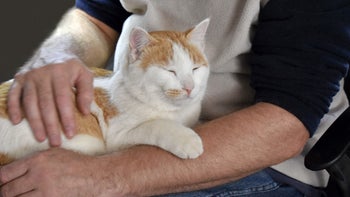
7 Common Reasons Cats Lick Themselves — and When It Becomes a Problem
Key takeaways:
Cats lick to show affection, bond with you and other cats, and groom themselves.
Licking excessively can signal that your cat has a medical issue, an allergy, or stress and anxiety.
You may need to take your cat to the vet for evaluation and treatment if they develop bald spots from grooming too much.
Access savings on related medications
Table of contents

If you have ever lived with cats, you know they all have different personalities. They also have distinct behavior patterns. Some are obsessed with cardboard boxes, while others wake you 2 hours before the alarm every morning (especially on the weekends). But nothing is more evident than one behavior they all have in common — licking.
Cats spend hours of their day licking themselves or grooming. They even have tiny, hollow spines on their tongues called papillae to help with their self-cleaning rituals. But why do they groom, why do they lick you, and more so, when is it too much? Let’s take a look.
Common reasons cats lick themselves
Cats lick for many reasons, just like humans talk for many reasons. Licking is one of the ways cats communicate. They may be trying to tell you that they adore you, or they may be trying to say something’s wrong.
Search and compare options
To better understand your fluffy feline, it’s important to know why your cat licks. Here are a few potential reasons:
1. Grooming themselves and other cats
Cats spend nearly 25% of their time grooming themselves. They have good reasons. Grooming helps them to:
Keep their fur clean
Get rid of odors
Shed loose hair
Move protective oils around their skin
Stay cool
Cats also like to spend time grooming other cats to bond with them and clean areas of their bodies they can’t reach themselves.
2. Managing the unexpected
Cats lick themselves when something hasn’t turned out the way they planned. Say, for instance, your cat tries to jump from a chair to a sofa but falls short and ends up tumbling to the floor. Their immediate response may be to lick themselves. It can mean they’re worried or confused about what just happened and need a moment to regroup.
3. Dealing with a medical issue
Your cat’s licking may signal a medical problem, such as an oral or digestive disorder or even nausea. Or, their skin might itch because of tree or grass pollen. Your cat may also lick if they’re in pain from a condition called anal sac impaction, a swelling or infection of their anal glands. Parasites, such as fleas or tapeworms, may lead to licking, as well.
Read more like this
Explore these related articles, suggested for readers like you.
In the case of licking, also be on the lookout for cats who stop grooming altogether. Cats are good at hiding signs of illness. If your cat stops grooming themselves, it may be a tell-tale sign that something is wrong. If you suspect a medical problem with your cat, take them to your vet right away.
4. Socializing
Cats enjoy grooming each other to establish a group scent. The scent helps them recognize members of their pack.
5. Soothing themselves
Licking has a calming effect on cats. It can help them deal with conflicts and stressful situations.
6. Cooling themselves
Some cats lick themselves to cool off in hot weather. Licking adds moisture to their fur. As the moisture evaporates, cats feel cooler.
7. Marking their territory
When cats lick themselves, they spread their scent around their environment. This helps them mark their territory and feel safe in their surroundings.
Why your cat isn’t eating: When cats stop eating, it can be a sign of a serious problem. Learn about the possible causes and what to do.
Medications for an anxious cat: If you’ve got a stressed-out cat, medication may help. These are the best medications for cat anxiety.
Cat acupuncture: Yep, you read that right. Here’s why one cat owner tried acupuncture for her cat’s asthma — and how it worked.
What does it mean when cats lick you?
Mother cats lick their kittens as babies to clean their little ones and make them feel secure. Cats also lick each other as a marker of social connectedness. This is called allogrooming. In turn, when your cat licks you, they’re accepting you as part of their family. Think of it as family bonding. You can return the affection by petting or brushing your cat, as well as playing with them.
Excessive grooming in cats: When to be concerned
If your cat seems to be licking too much, it could mean something’s wrong. Here are some reasons your cat may be overgrooming.
Stress and anxiety
It’s possible your cat may be licking because of stress or anxiety. Licking has a way of calming them, much like a pacifier for a baby. The problem is that a cat may lick excessively and groom themselves bald in spots.
Cats that lick because of stress are considered to have a behavioral issue rather than a medical one. In some cases, licking can become an obsessive behavior that continues even after the stressors are gone.
Pain
If your cat is experiencing pain, they may overgroom. Cats lick painful areas on their bodies. Your cat may be responding to joint discomfort, for example. Or they may lick to ease the pain of a urinary tract infection.
Allergies
Cats can be allergic to fleas, food, and other environmental factors. These allergies can cause their skin to itch. As a result, they may lick their fur to ease the itch.
Parasites
Some cats become infested with microscopic skin mites. Mites can irritate skin, causing itching, hair loss, and inflammation. Other parasites — such as fleas — can also cause itching. Any time your cat is itchy, they may overgroom to relieve the discomfort.
Ringworm
Ringworm is a fungal skin infection that can cause itchiness in cats. Cats with ringworm may lick themselves as a way to manage the discomfort of the infection on their skin.
Hyperesthesia syndrome
Hyperesthesia syndrome, also called rolling skin disease, is an intense sensitivity to being touched. Veterinarians aren’t sure what causes it, but symptoms include overgrooming, biting, twitching, and scratching.
How do vets help cats who lick too much?
If your cat licks so much that they develop bald patches — also called alopecia or hair loss — your vet may suggest several treatment options, depending on the cause of your cat’s licking. Here’s how your vet might help:
For allergies and other infections
If your vet determines that a food or skin allergy, fleas, worms, or other infections are the cause of your cat’s licking, they will recommend treatments to address the underlying cause of itchiness and irritation.
For medical conditions
If your vet suspects that a medical condition may be at the root of your cat’s overgrooming — such as anal gland issues, hyperthyroidism, or an illness that causes pain — your vet may recommend additional testing to determine a cause and treat your cat’s symptoms.
For stress
If your cat is licking because of stress, your vet may suggest making changes to your cat’s environment to reduce their anxiety. Vets can also prescribe medications to help with your cat’s anxiety — such as fluoxetine (Prozac), amitriptyline, or gabapentin — if needed.
For hair loss and broken skin
If your cat’s grooming has caused hair loss and broken the skin, they have a higher risk for getting an infection. Your veterinarian may recommend ways to prevent or treat an infection caused by too much licking, such as antibiotics. Your vet may also suggest that your cat temporarily wear an e-collar or cone to protect the affected area so it has time to heal.
For hairballs
When cats groom, they swallow some of the fur that gets caught on their tongues. Normally, this fur gets processed through your cat’s digestive system. But sometimes cats will throw up a hairball, especially if they have been doing a lot of extra grooming. Your vet may recommend a hairball remedy to help your cat manage the extra fur in their digestive system. You can also help by regularly brushing your cat.
The bottom line
Cats lick for a variety of reasons. Sometimes it’s to show love and affection, and at other times it’s due to stress or an underlying medical issue. If you notice that your pet starts licking so much they develop bald spots, it may be time to give your veterinarian a call to address any underlying issues. If your cat stops grooming altogether, that’s another reason to head to the vet. If your cat licks primarily to groom themselves and bond with you, return the favor by cuddling, playing, and gently brushing them back.
Why trust our experts?



References
American Veterinary Medical Association. (n.d.). Feline lower urinary tract disease (FLUTD).
Brooks, W. (2023). Hyperesthesia syndrome in cats. Veterinary Partner.
Cornell Feline Health Center. (n.d.). Cats that lick too much. Cornell College of Veterinary Medicine.
Curtis, T. M., et al. (2003). Influence of familiarity and relatedness on proximity and allogrooming in domestic cats (Felis catus). American Journal of Veterinary Research.
Hamilton, J. (n.d.). The importance of e-collars. The MSPCA-Angell.
Litchfield, C. A., et al. (2017). The ‘feline five’: An exploration of personality in pet cats (Felis catus). PLOS One.
Lundgren, B. (2020). Hairballs in cats. Veterinary Partner.
Maciorakowski, L. (n.d.). Overgrooming cats. The MSPCA-Angell.
The MSPCA-Angell. (n.d.). Why your cat grooms so much.
Moriello, K. A. (2020). Alopecia in animals. Merck Veterinary Manual.
Noel, A. C., et al. (2018). Cats use hollow papillae to wick saliva into fur. Proceedings of the National Academy of Sciences of the United States of America.
Weir, M., et al. (n.d.). Anal sac disease in cats. VCA Animal Hospitals.





























